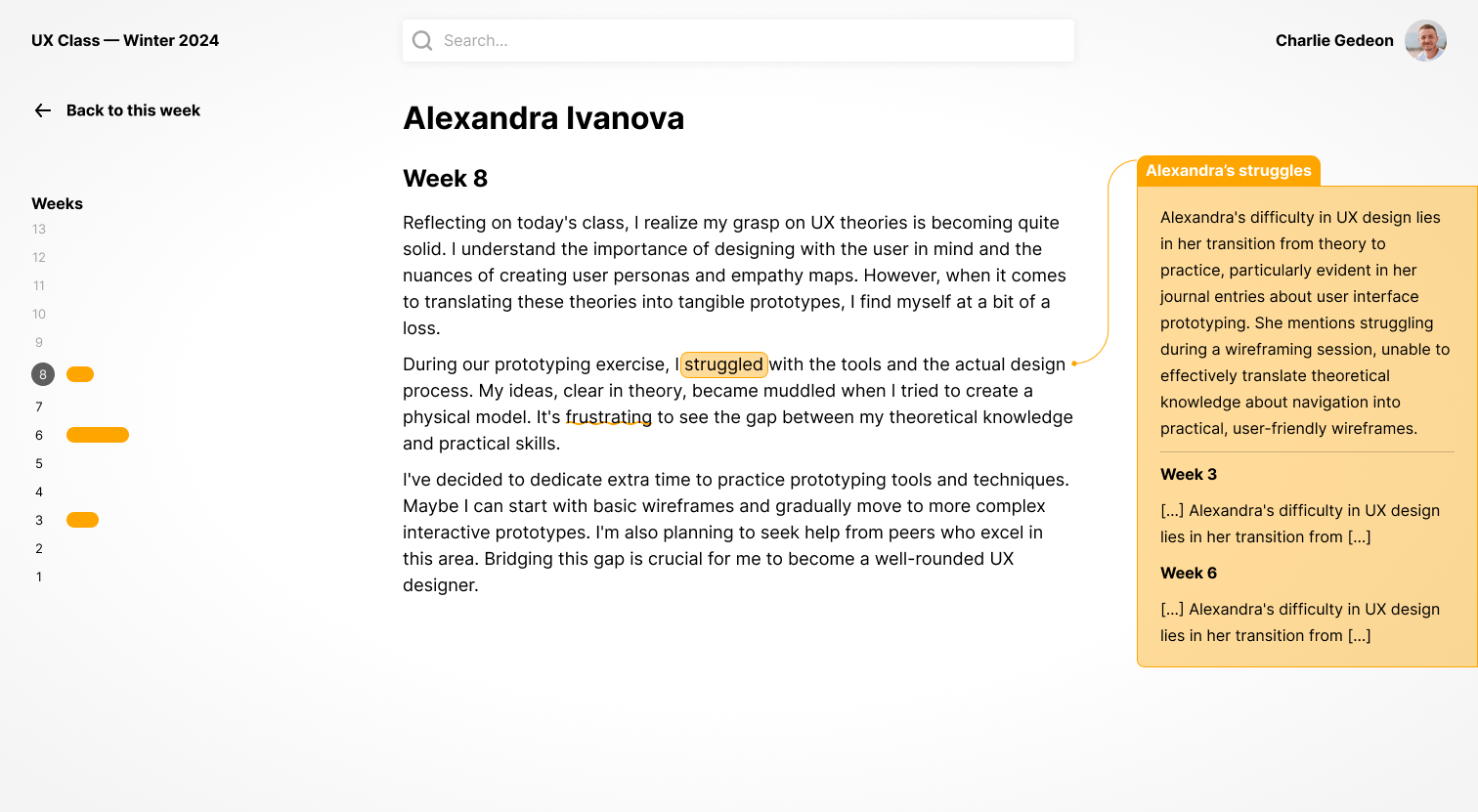One of the best parts of building experiments in public is how the ideas can evolve by others. When we recently shared a video of how AI can help metacognition in the classroom, someone reached out to us to say that this might also be relevant in UX research.
Though this might be obvious to outsiders, we were knee deep in thinking about classroom interactions so we missed this idea. Taking a step back, it actually does make a lot of sense.
In any research, metacognition—thinking about your own thinking—has always been crucial for ensuring your outputs are well-considered and lack bias. In design, this capacity is what enables designers to course correct when they are leaning too much into their own world views. It’s a critical skill for creating user-centered designs. With advances in AI, there’s growing potential to combine AI's ability to process vast amounts of qualitative data with metacognitive reflection. However, it’s important to approach these possibilities thoughtfully.
Dovetail, one of our favourite UX research tools, has shared their vision of AI, emphasizing AI’s capacity to accelerate research by clustering insights and automating theme detection. This efficiency could shorten the time between research and its demonstration of value, potentially increasing companies' willingness to invest in UX. However, with this speed comes the risk of bias or missed insights. While Dovetail clearly states the value of human oversight, we were curious about what the oversight can look like, and how it would behave.
We see AI’s role in UX research going beyond acceleration—it has the potential to help researchers think deeper, by not only identifying patterns but also prompting reflection on missed or under appreciated insights.
The Role of Reflection in UX
Reflection is crucial in understanding why a UX researcher may reach certain conclusions. While AI can detect patterns in feedback, simply adding disclaimers about its inaccuracies isn’t enough to ensure reflection. We need interfaces that actively encourage researchers to think critically about their own decisions and recommendations.
In the video above exploring an interface for learning, we explored how targeted reflection surveys help students challenge their assumptions. What if UX tools offered similar reflection checkpoints, acting as a "sanity check" for researchers before they finalize their recommendations?
Integrating reflection tools directly into AI-powered interfaces would prompt researchers to question their assumptions and refine their thinking before moving forward.
AI as a Reflective Partner
We know that AI can detect patterns and suggest themes researchers might overlook. For example, it can identify sentiment trends or recurring pain points across user groups. But AI, while fast, has its own limitations—such as biases introduced through training data. That’s where the partnership between human researchers and AI becomes crucial. In another experiment, we show how a combination of tagging, and connections can become a type of “Inspector” for words, like those in browsers developers use when coding.

The AI would explain what it’s saying but defer to human judgment since it’s essential for interpreting the deeper context. The goal is to ensure that the analysis remains grounded in the real-world experiences of users.
AI and Metacognitive Growth in UX Research
While AI holds promise for UX research, we remain cautiously optimistic. AI can help researchers identify overlooked themes and encourage reflective thinking, but human insight is irreplaceable in understanding the deeper meaning behind user feedback. Like the “big data” hype before it, it’s important we don’t delude ourselves about the objectivity of what machines give us. Jer Thorp says it best in his post, You Say Data, I Say System.
Any path through a data system starts with collection. As data are artifacts of measurement, they are beholden to the processes by which we measure. This means that by the time you look at your .CSV or your .JSON feed or your Excel graph, it has already been molded by the methodologies, constraints, and omissions of the act of collection and recording.
Simply by measuring the data we are transforming it in imperceptible ways. What we’re very excited about is a new category of interfaces for analysing qualitative data with unprecedented clarity. There may a way to make the subtle transformations that happen when we collect qualitative information more explicit. While we don’t think that any analysis tool will ever be perfect or free of biases, we do believe that there’s a fresh opportunity upon us to deepen our understanding of that which can’t be counted.




